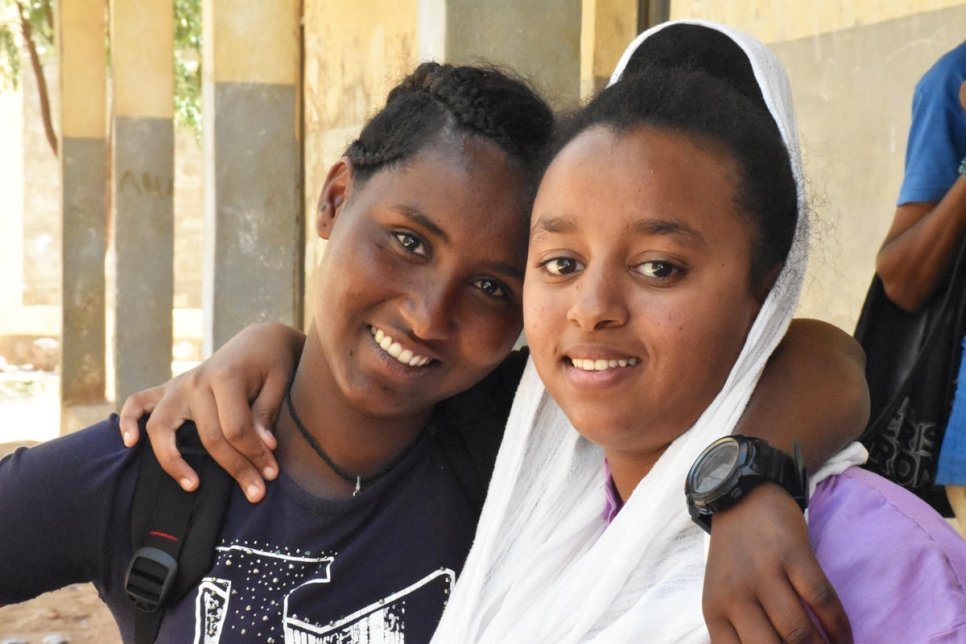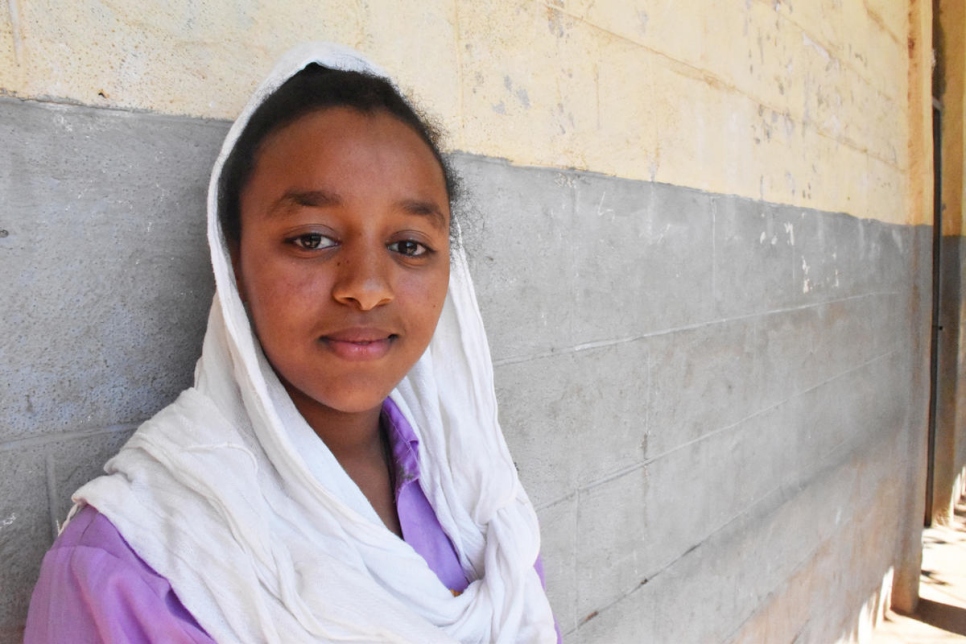Global Compact in Action: Refugees and Ethiopians go to school together
Progressive refugee laws in Ethiopia enable refugees and Ethiopians to study together and share resources.
Misgane (left), an Eritrean refugee with her friends at their school in Tigray, northern Ethiopia
© UNHCR/Helle Degn
In a class room at Mai-Aini Secondary School in Ethiopia’s Tigray region, five youngsters aged between 14 and 18 play outside during their break. Two of them are refugees; the other three come from the local community.
Going to the same school, they have become close friends.
“We play, study and live side by side," says one of the boys, Mike. "Some are refugees, some are not. It doesn’t matter. We live in harmony.”
The other students gesture in agreement. “We are friends,” adds Adhanom.
“We play, study and live side by side."
Mike and Misgane both fled from Eritrea and each of them lost contact with their father. They bow their heads as they reflect on what this reality means for them. Not knowing where their fathers are is difficult to comprehend.
In Ethiopia, Mike and Misgane, together with their families are part of 173,900 Eritrean refugees that have found safety here. The two live in the Mai-Aini Refugee Camp and have access to the nearby Mai Aini Secondary School along with children from across the region. Refugees here are part of the national school system.
Most Eritrean refugees live in camps in the Tigray and Afar regions of Ethiopia, but some live within the host community as part of the Government’s Out-of-Camp Policy.
Ethiopia has a long-standing history of hosting refugees and has kept its doors open for new arrivals, allowing humanitarian access and protection to those seeking asylum in its territory.
This year, the country passed one of the most progressive refugee policies on the African continent - Ethiopia’s new Refugee Proclamation. This grants refugees and asylum-seekers the right to work, move freely and choose where to live, as well the freedom to leave the country and come back at any time.
The proclamation is an example of how the Global Compact on Refugees, which was adopted by the UN General Assembly in 2018 to call for greater inclusion of refugees in the communities that host them, can be supported.
“By passing this historic legislation, Ethiopia not only serves as a role model for countries in Africa, but for countries across the world,” says Ms. Clementine Awu Nkweta-Salami, UNHCR's Rpresentative in Ethiopia.
“By passing this historic legislation, Ethiopia serves as a role model for countries in Africa [and] the world,”
The Ethiopian Government has made 9 significant pledges, embodying a vision where refugees would gradually be allowed to live out of camps, work, cultivate land, access national education and health services, as well as national birth and vital events registration. For those who have spent more than 20 years in Ethiopia, access to opportunities for local integration is also foreseen.
See also: UNHCR welcomes Ethiopia law granting more rights to refugees
The move from a camp-based approach to an increasingly integrated model of refugee assistance will be guided by the Government‘s ten-year National Comprehensive Refugee Response Strategy (NCRRS) that will be adopted in the year.
“In order to make the implementation of the new comprehensive refugee response a success, additional resources from the private sector and from development actors are needed, to make new investments and create opportunities for employment to the benefit of both refugees and host communities,” adds Ms. Nkweta- Salami.
The secondary school in Mai-Aini is supported by the Government of Denmark. In Ethiopia, the Government of Denmark, the Ikea Foundation and the Korea International Cooperation Agency, contribute to strengthening access to secondary education for refugees, as well as host communities. Denmark also supports access to tertiary education for refugees along with Germany through their ongoing DAFI scholarship programme.
The Mai-Aini Secondary School has 235 refugee students and 383 students from the host community. Learning is free here and the students are also provided with learning materials like books and stationery.
For Mike and his friends, they have the opportunity to think about the future and have big dreams. Mike wants to become a psychiatrist, while Misgane dreams of becoming an engineer.
“I am happy to be getting an education because it will help me achieve my dreams.”
Their Ethiopian friends Adhanom and Tirhas share Misgane’s dream of becoming an engineer while Yemane, wants to be a doctor.
“I am happy to be getting an education because it will help me achieve my dreams,” said Mike.
Leaving the class room, some head to the football field while others read books. All of them enjoy their time at school, before they head home where they help with house chores and study to prepare for the next day.


